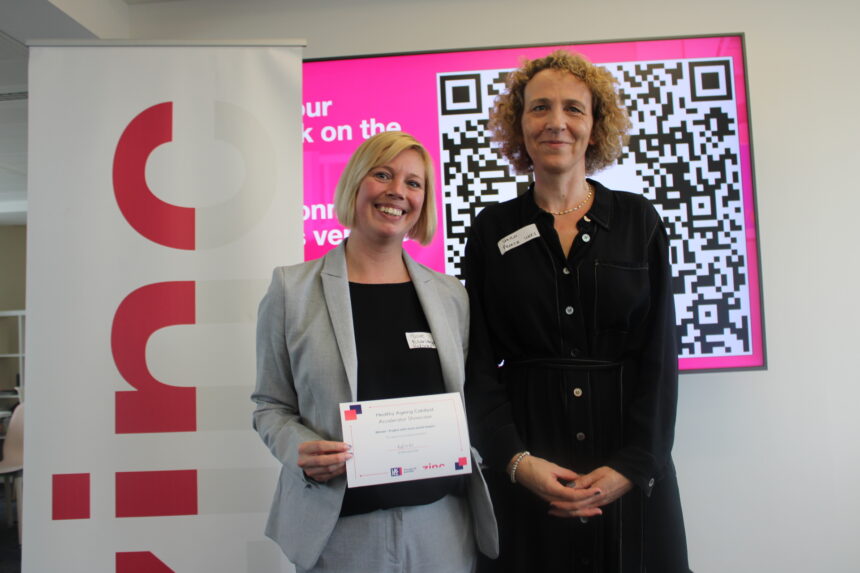Impact Innovators at Zinc: Dr Suzanne Eldridge, co-founder of ReFleks

Osteoarthritis (OA) is a degenerative joint disease characterised by cartilage loss without cure. It causes joint pain and is a leading cause of disability worldwide, costing ~ 1.5-2% of the GDP. Read our interview with Dr Suzanne Eldridge (Queen Mary University of London) about their journey with Zinc as they drive forward their solution, ReFleks.
Dr Suzanne Eldridge’s insights shed light on the challenges and potential breakthroughs in tackling osteoarthritis through innovative solutions like ReFleks. Her dedication to understanding the underlying causes of joint failure and developing targeted therapies is inspiring. By harnessing the power of research, entrepreneurship, and collaboration, we can envision a future where individuals affected by osteoarthritis regain their independence and quality of life.
To kick off, we’d love to hear about your background and what brought you to Zinc.
I used to have a passion for science and maths and discovering things and understanding things. At the end of my engineering degree, I chose to do a master’s in medical engineering, looking at engineering medical interventions for the human body, ranging from joint replacements to equipment like basic stethoscopes and hospital beds. My main focus was looking at why joints fail or heal. When joints fail, joint replacement is essentially the only option. Still, joint replacements have many issues: particles can come off the prosthesis and cause inflammation, sometimes pain persists, and they only last 10-15 years. I was looking for ways to understand why the joints failed in the first place to avoid the need for joint replacement.
This challenge is fundamental now, with an ageing population, as the lifespan of a joint replacement is about 15 years. If you’re getting one at the age of 60, you’re going to need revision surgery when you’re 75-80, which is just not good.
I started exploring more about the biology of the joint and the reasons for its failure. So, I undertook a master’s of research at the William Harvey Research Institute, working with Professor Francesco Dell’Accio (co-founder of ReFleks), exploring potential therapeutics that cause cartilage growth and regeneration. That led to a PhD and the first molecule we patented for cartilage regeneration and repair.
One main challenge is understanding who to treat and whom not to treat with Agrin. Which patients are going to benefit the most? Forty per cent of people who have had a joint injury will go on to get osteoarthritis, but there’s no way of knowing who. Within the Barts BRC, we are setting up a cohort where we’re going to clinically follow up on patients who’ve had joint trauma, looking at MRIs and X-rays, taking blood samples, and measuring muscle functions.
We were lucky to receive a UKRI Catalyst Scheme grant with Zinc to develop an app that gathers all this information without the patients needing to visit the hospital. The app will give us information about how often the patients have taken painkillers and their exercise levels, and it will also provide them with an opportunity to hand in surveys that they would typically have to come into the clinic to do.
After one year, we will know which patients developed osteoarthritis. We can look at the data to see if any tell-tale sign at the start indicates that that particular patient would go on to get osteoarthritis. Hopefully, we can rely solely on the app rather than these costly clinical measures in the future.
More importantly, we can identify which patients will benefit from our treatments. We don’t need to inject or give people who wouldn’t usually get osteoarthritis an intervention because they don’t need it. This identification makes our clinical trial much stronger.
Knowing which patients will benefit most from our intervention will not only avoid treating patients who do not need it—with obvious cost implications and unnecessary risks of side effects—but also make our clinical trials more robust, increasing the chances of achieving clinical benefit for patients.
To date, has it been unpredictable to see which 40% of people go on to get OA?
There’s no way of predicting it precisely. Old age and high obesity are risk factors, but they do not allow a precise prediction. Patients come into the clinic years down the line and are diagnosed with osteoarthritis. The orthopaedic surgeons say, come back when it’s terrible, and we’ll give you a joint replacement, but there’s no treatment; there’s only symptomatic relief. So, people end up relying on painkillers quite a lot until they have a joint replacement. That is a lot of disability for our patients, and it is tough to accept. It affects their quality of life and independence – some will struggle to get in and out of a bath, cook or get dressed independently, and some will become unable to work. Osteoarthritis is the first cause of absenteeism in the UK. It is a disaster for our patients and is costly and wasteful for society.
What was it about ‘why joints fail’ that interested you?
If you are young and healthy and dent your cartilage, it will likely heal. It will take time, but it heals. That is why we can run, play sports, jump and fall on that 2mm-thick layer of elastic tissue for years, and we get away with it. But when the mechanisms that generally support healing for a reason or another fail, then the joint will fail. This was exciting because if we could understand what was going on and which molecules support successful healing, we could take the same molecules and give them as medications to support healing when natural healing fails. That is precisely what we did, and that’s how we identified Agrin as a pro-regenerative molecule.
What risks did you identify with this path, either with the solution or entrepreneurship?
There are many risks, including needing more funding and recruiting the right people for the team. Drug discovery also has intrinsic risks, such as unexpected side effects. These are what makes it so challenging, and competition is fierce.
One risk regarding the app we developed was that our expertise was outside of app development. Thankfully, Queen Mary Innovation put us in touch with Dr Hamit Soyel, the CEO of Deep-C Vision, who has also developed apps and showed us approaches that had been successful for them.
On the entrepreneurial side: It’s been thrilling and exciting, but all very new, so there was much opportunity for failure and learning. Zinc, a venture builder, has been fantastic in that they’ve guided me every step of the way. They’ve pointed me toward the right sort of people to talk to and exposed me to speak to many people. You learn things every time you have a conversation with somebody.
What drove you to grow this venture at Zinc, and what areas did you find the most supportive?
On the face of it, Zinc is like many other companies until you get to know the people and how the system works. They don’t just say “we have somebody who will look at your IP, we have somebody who will help you craft your pitch, we have someone who can help you build your business plan” – they are the people doing it. You’re talking with them, you’re meeting with them, and they’re explaining things as they go along. It’s very in-house, and that personal touch is perfect.
Each step of the way, they’ve been incredibly supportive.
Zinc have introduced me to their contacts and their groups of investors, which has given me a much more comprehensive platform to showcase our work. For example, they suggested I apply to deliver a pitch at the Ageing Fit conference in Lille; UKRI then provided the funding to get there and pitch on the back of that. That gives us a lot of international exposure and helps us build a solid network. We will showcase what we’re doing to Europe now, not just within the UK.
What are some challenges you’re currently facing as a founder?
It takes work to balance an academic career and setting up a company simultaneously. Before Zinc came along, we had been doing this slowly in the background. Only now have we been given such a boost of energy, enthusiasm, skills, the right people, and connections to propel this forward. But striking that balance is tricky.
What does success look like to you?
For us, we want a drug in patients. We want to get into the market for the benefit of patients. If we manage to do that, it will be transformative. We will have made a difference. The impact will be tangible: patients will regain their independence, their way of providing for themselves, and ease for those on whom they depend. For society at large. To get back into work and feel they are contributing to society rather than being a burden. Osteoarthritis is a disease of old age, and yes, our society is becoming increasingly reliant on older adults being productive and healthy. Still, osteoarthritis is becoming more and more frequent in younger people, too. It is an epidemic. Success in this field would be incredibly impactful. This is what success looks like to us.
And do you envisage that the NHS will deliver this treatment?
Of course! Considering the treatments, the consultations, the disability and the loss of productivity, governments in Western countries spend between 1 and 2.5% of the entire GDP for osteoarthritis. That is a fortune! Reimbursing an effective therapy in osteoarthritis is an immediate saving! That is why, in 2018, the FDA in the US recognised OA as a severe disease with an unmet medical need for therapies that modify the underlying pathophysiology of the disease and potentially change its natural course to prevent long-term disability. This enables companies to apply for “fast-track” approval and shows that the governments are prepared to meet the costs because such costs ultimately save money. because
Do you have any advice for other academics looking to start their entrepreneurial journey?
Speak to Zinc; start with Zinc! They’re accommodating, especially for people beginning, learning, understanding, and exploring the process.
How can the UK become the place for this innovation and groundbreaking solutions?
There are three aspects. First: education. Innovation needs education and strong universities, and if we want to lead in innovation, we must support education at all levels, including a more robust career structure in academia. Two: we need to make recruiting and retaining talent easy. Complex and hostile immigration policies do not help at all. Three: availability of investment. The spillage of startups and established companies from the UK to the USA is on the news daily. We need the instruments to support ambitious growth within the UK.
Thank you to Dr Eldridge for their time. To stay informed about the Zinc. ecosystem and innovations in healthcare, sign up for our newsletter today and be the first to receive exclusive content!
Join the Zinc community
Stay up to date with all Zinc updates and future posts as part of our fast growing community.
Featured Resources
Zinc Impact Report 2024
Zinc’s mission is to make the UK the best place to successfully start a venture which can have a massive impact on the health of people and the planet.
Increasingly, we are building deeper science ventures that serve global, industrial customers in environment and health, giving access to impact at a global scale.
Our 2024 Impact Report explores the challenges that need to be tackled to empower and enable talented founders from around the world to solve critical health and environmental challenges at scale, from here in the UK.
This report showcases success stories from the Zinc portfolio, and highlights how Zinc – and our growing community of hundreds of Founders, Fellows, Coaches, Partners and Funders – are working together to build a world-leading “Science-for-Impact” ecosystem for inception stage ventures in health and environment.
Impact Report 2023
We started Zinc with the hypothesis that missions are an effective way to attract highly ambitious, talented and experienced groups of innovators, who might not recognise themselves as “classic entrepreneurs” but are ready and able to start a new commercial and successful venture to tackle some of our most pressing societal issues.
The world has overcome the sorts of challenges we face today when it has adopted a mission-based approach to the biggest problems and brought together world-class talent to invent and innovate, e.g: NASA and landing a man on the moon, the LSE blueprinting the British welfare state, or the Gates Foundation aiming to eradicate diseases.
On this basis and assumption, we designed Zinc as a new mission-based Venture Builder — a place where global talent, ‘impact makers’, can join to experiment and develop new solutions to our most pressing societal issues.


